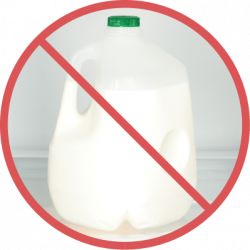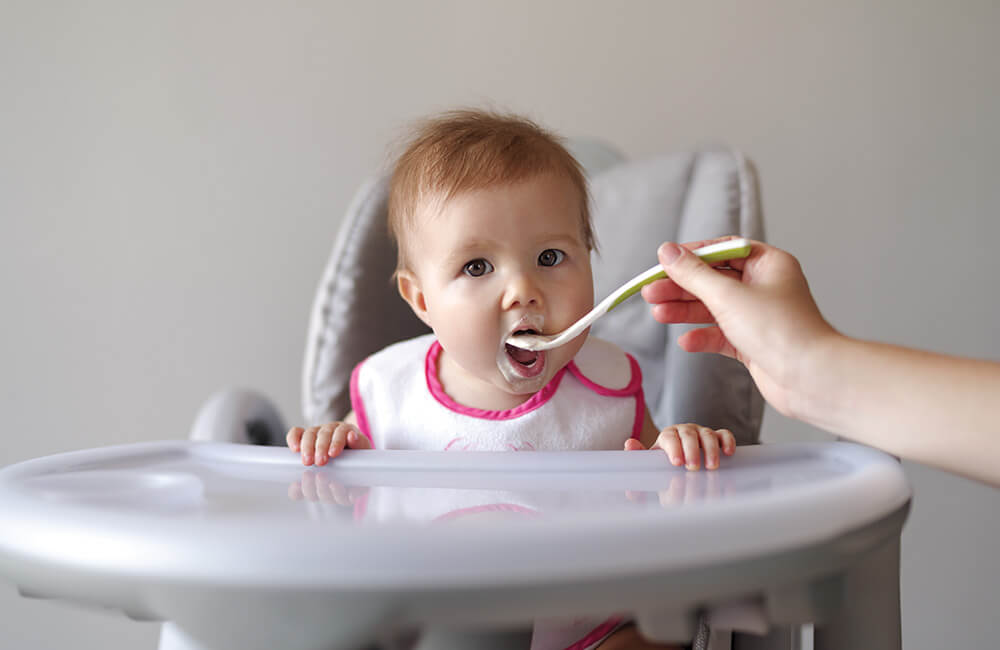Caring for your babyBirth to 6 Months
- Home
- Infants
- Growth & Development
- Birth to 6 Months



Always add water to the bottle first, then the powder formula. If you have any concerns about the safety of your tap water, consider using bottled distilled or boiled water cooled to a safe temperature for me.

Start by offering only a small amount at a time, 2 to 3 ounces of breast milk or formula.
Let me be in control of how fast I drink from the bottle.
Trust me to know when I am satisfied. Look to me for my signals. Please don't make me finish a bottle.
Keep prepared bottles in a refrigerator until you are ready to feed me and use them within 24 hours.
Never microwave breast milk or formula. “Hot spots” can burn my mouth. Ouch! Warm up my bottles in hot water instead.
I may move a lot or turn my head and open my mouth. I may suck on my hand or fuss. Please feed me before I cry. I eat best when I am calm.
I stop sucking and spit out the nipple. I may look relaxed or sleepy. If I get too full, I might frown, fuss, and kick to let you know I'm done. Please don't keep trying to feed me.
I wet 6 or more diapers a day and the doctor says I am gaining weight and growing well. Please do not put me on a feeding schedule. I will let you know when I am hungry or satisfied.

– Pay attention to my cues and feed me when I want to eat, when I’m wide-awake and calm and before I get upset from crying.
– Sit still when you are feeding me. Keep the feeding smooth and steady.
– Let me eat my way – much or little, fast or slowly, steady or start-and-stop.
– Stop feeding when I show you I am finished eating. I will relax, slow down, and stop nursing.
– Talk or play awhile after I’m done eating. Put me to bed when I’m calm and drowsy and let me put myself to sleep.
© Copyright 2024 by Ellyn Satter published at EllynSatterInstitute.org. https://www.ellynsatterinstitute.org/how-to-feed/child-feeding-ages-and-stages/
– Feed me when I want to eat, when I’m wide-awake and calm.
– Let me eat my way – much or little, fast or slowly, steady or start-and-stop.
– Bring me to the table with you when you eat. I love being with you, and I begin learning what eating is all about.
– Talk or play awhile after feeding. Put me to bed when I’m calm and drowsy and let me put myself to sleep.
© Copyright 2024 by Ellyn Satter published at EllynSatterInstitute.org. https://www.ellynsatterinstitute.org/how-to-feed/child-feeding-ages-and-stages/
All babies are different. I may eat different amounts from one day to the next. As I become older and my stomach grows, I may eat less often, but can eat more at each feeding.


If I am growing poorly, these signs might also indicate I’m having trouble latching on or swallowing.
I might spit up if you try to feed me when I am full or if you bounce me after I eat.
I swallow air when I eat. Too much air makes me spit up or have gas. Burping helps me get the air out. Wait for me to stop eating before you burp me. Hold me so my tummy touches your chest or lap. Gently pat or rub my back.
I might grunt and turn red to move my bowels. I might have 1 to 3 bowel movements a day or none for a day or 2. This is not constipation. Constipation is a hard, dry stool that hurts to pass and makes me cry.
As I grow, my routine might change, and I may want to eat and sleep more than usual. These are called growth spurts.
All babies are different, but my growth spurts might happen when I’m around the ages of:
4 TO 6 WEEKS
4 MONTHS
9 MONTHS
3 MONTHS
6 MONTHS
4 MONTHS
9 MONTHS
Your body also knows what I need and will make more milk to keep up with my growth spurts. The more often you breastfeed or pump, the more milk you will make.
If I act hungry after I finish a feeding, offer me the breast again. If I am taking a bottle, offer me a bit more until I show signs of being full.

Playing helps me learn, improve coordination, build strength, explore, and bond with you!
Birth to 3 Months

The world is new to me. It can be scary. I may cry a lot at first.

I must learn what day and night are.

I know your voice.
4 to 6 Months

I start to settle into a routine.

I’m growing strong
and active.

Please read to me.
Follow the A, B, C’s of safe sleep:
A – Alone
B – On my Back
C – In a Crib
We can share a room, but not the same bed. I could suffocate if a pillow or toy covered my mouth or nose. Put me in my crib, alone, on my back to sleep. Use a firm mattress. Do not put pillows, quilts, bumper pads, or toys in my crib.


Wipe my gums and teeth with a clean, wet, soft cloth or a soft rubber or silicone finger brush after every feeding. Schedule my first dental visit as soon as my first teeth appear, or by my first birthday, and begin using a soft toothbrush with a rice-sized amount of fluoride toothpaste twice a day. Always watch me to make sure I don’t swallow the toothpaste.

Wait until I am able to sit up on my own and open my mouth when I see food coming. This is usually around 6 month of age.
If I’m given solid foods before I’m ready, I could choke or get sick.


Wash your hands before making my food and feeding me.
Keep me away from tobacco smoke. It hurts my lungs.


Never leave me alone at bath time or while changing me.
Buckle me into an infant car seat in the car. Learn how to install the seat correctly, in the car's back seat, facing backwards.

DO NOT let me have these foods until I am at least 1 year old:

Cow’s milk or other non-dairy milks (like soy or almond milk). It’s too hard for me to digest and may cause health problems.

Honey and foods made with honey. Honey can contain bacteria that cause infant botulism, or food poisoning. These bacteria are harmless to older kids and adults.

Check out the Wyoming WIC Infant Feeding Guide to learn more!
For additional support, contact your local WIC Breastfeeding Peer Counselor or WIC Designated Breastfeeding Expert for breastfeeding questions.
Install this web app on your iPhone: tap ![]() and then Add to Home Screen.
and then Add to Home Screen.
Side-Lying Hold
This hold is useful when:
Cross-Cradle Hold
This hold is useful when:
Clutch or “Football” Hold
This hold is useful when:
Cradle Hold
This hold is useful when:
Laid-Back Hold
This hold is useful when: